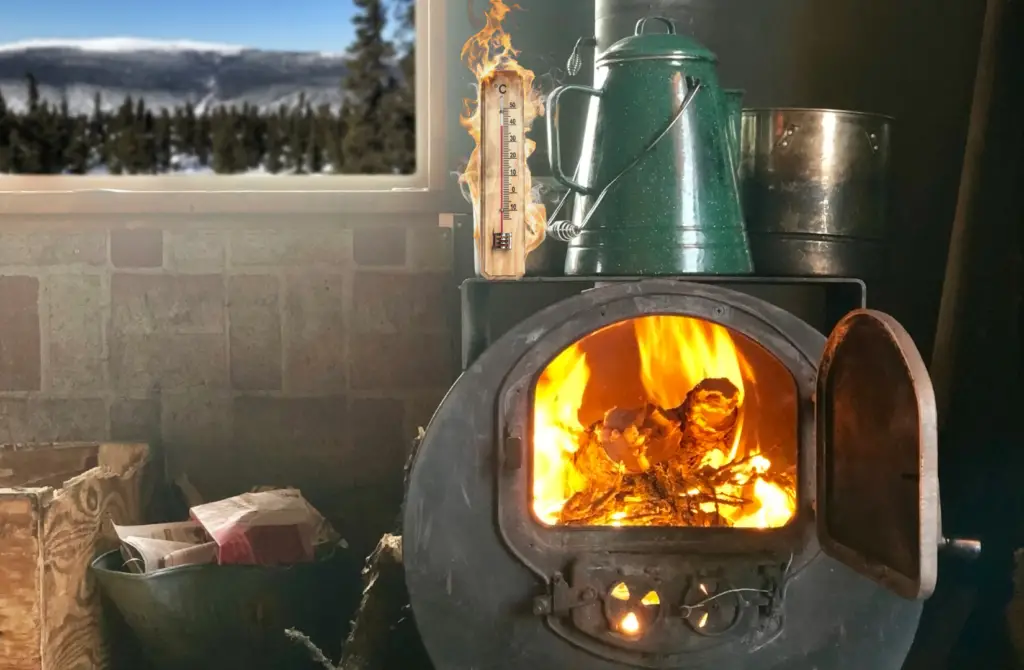Learning about the optimal temperature of your wood-burning stove can optimize its performance; the temperature at which wood-burning stoves burn varies.
A typical catalytic wood-burning stove generates 350-1500°F. The catalytic combustor gets activated at around 500°F and burns the smoke and gasses generated by the fire—a process known as secondary combustion. Try to keep the operating temperature between 500 and 800°F.
Curious to discover how an optimal temperature minimizes smoke and byproducts? Read on to find out more as this post explains the wood-burning stove’s combustion process and helps assess its efficiency.

What temperature does a wood-burning stove reach?
Firewood burns in stages, and you do not feel the heat at the initial stage of the combustion. The first stage, which involves the evaporation of moisture, can be frustrating if you are burning insufficiently seasoned wood.
The evaporation of the moisture content requires a temperature of up to 212°F. At this stage, you will not feel the heat generated by the weak combustion.
When the temperature is within the range of 212°F-450°F, the combustion releases creosote-causing gasses such as carbon dioxide and formic gasses. Hydrocarbon compounds are released as the temperature exceeds 540°F.
From there to 900°F, the combustion releases plenty of water vapor, carbon dioxide, methane and other unburned combustible gasses. These gasses, the burning of which is known as secondary combustion, does not naturally occur until the temperature has reached 1100°F.
Designers of wood-burning stoves have found a short-cut way to burn the gasses and thus increase the efficiency of the stoves. A catalytic wood-burning stove has a honeycomb-shaped ceramic component—a combustor—that burns the gasses when the stove temperature has reached 500°F.
To get the advantage of this component, you must burn sufficiently seasoned wood and the temperature must reach 500°F. That’s why it’s important to avoid buying a wood-burning stove that’s too large for the space the stove is intended to heat. If you have too big a stove, you will tend to operate the stove at suboptimal temperatures, leaving the catalytic combustor unused.
Where to measure wood stove temperature?
If you own a wood-burning stove, make sure you have a thermometer so that you can measure the temperature and adjust the fires when needed. A wood stove thermometer is a small device with a flat design that features a dial indicating the current operating temperature.
The placement of a wood stove thermometer depends on the type of thermometer you have. There are two types of thermometers for single-wall stoves: stove pipe thermometer and stove top thermometer.
A stove pipe thermometer is stuck to the stove pipe, about a foot above the stove top. This thermometer reads the temperature inside the pipe. A stove top thermometer, in contrast, is installed on top of the stove, held by a magnet.
On a double-wall stove, however, neither of these two types provides accurate readings. In such a case, you have to use a stove pipe probe thermometer, which is inserted in a hole in the pipe, and reads the temperature of the air flowing inside.

What temperature is too hot for a wood-burning stove?
A safe range of temperature for a wood-burning stove is 400°F-900°F. If the internal temperature exceeds 900°F, it can cause a fire inside the pipe.
The temperature generated by a wood-burning stove depends on the type of stove and the quality of wood. Larger stoves achieve high temperatures quicker than smaller ones, in part because a large unit can accommodate more wood.
If a wood-burning stove constantly burns at a temperature higher than 900°F, the combustion can cause fires inside the stove pipe and damage the firebox.
A stove thermometer is a useful device that can help you use your wood stove safely and efficiently.
How to maintain optimal wood stove temperature?
Extremely high temperatures are risky, but you do not want to operate your wood stove at a suboptimal temperature either. As long as the temperature is below 400°F, the combustion produces excessive smoke, carbon dioxide and other undesirable byproducts.
The key is to keep the range between 500°F and 800°F. There are three things you can do to maintain this optimal temperature.
First, be sure to burn sufficiently seasoned dry wood only. Wet wood burns less efficiently and produces less heat and more CO2.
Second, light the fire appropriately because the way you do it determines the efficiency of the stove to some extent. Before you add large logs, make sure the kindling is glowing hot.
And third, avoid overfilling or under-filling the stove. Too much wood will cause the stove to burn too hot, and too little will cause it to operate at suboptimal temperatures. Read the user manual and use the amount of wood recommended by the manufacturer.
Does a wood-burning stove burn hotter with the door open?
No, it’s just the opposite. When the door is shut, no heat escapes and therefore the stove is about 60% more efficient. Leaving the door open means not having enough control over the airflow of the stove. Once you have managed to make a fire, shut the stove door.
The inside of a wood-burning stove is a sealed atmosphere that contains fire. The metal frame absorbs the heat and then radiates it into the room. Even if the fire has died down, the residual heat in the metal frame can keep your room warm.
If the door is open, the heat escapes, and the metal walls do not absorb enough heat to radiate into the room. Suboptimal operation not only makes the stove less efficient but also creates condensation inside the stove and the flue pipe.
There is another reason it’s important to keep the stove door shut. Secondary combustion, which requires at least 500°F in a catalytic wood stove, may not take place if the door is open.
How do you cool down a wood stove that is too hot?
You can cool down your wood-burning stove in multiple ways. The most obvious way to do that is to reduce the airflow to the fire by coking down the damper. But do not completely close the damper, because doing so will cause the stove to generate plenty of smoke.
The second way is to turn up the blower—if your stove has one. Turning the blower up essentially means dispersing the heat and thus causing the stove to cool faster.
The third tip is an easy one: just open the doors and windows of the room to create draughts. This will cause warm air to escape the room, making it cooler.
Another way to cool down a wood stove is to open the stove door wide. It stops secondary combustion and the stove generates less heat.
Conclusion
The temperature generated by a wood-burning stove ranges between 350°F and 1500°F. In a catalytic stove, secondary combustion takes place once the temperature has reached 500°F. While the temperature can be as high as 1500°F, it’s not a good idea to allow it to exceed 800°F.
Use a wood-stove thermometer to read the temperature and keep it within the safe range. It’s pretty easy to cool down a wood stove that is too hot. As with any combustion-based appliance, use your wood-burning stove carefully and responsibly.
